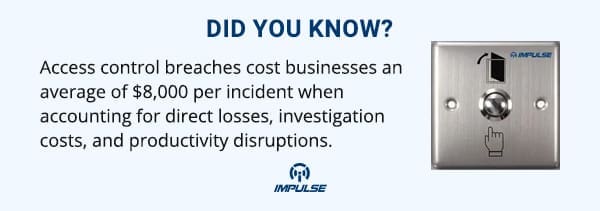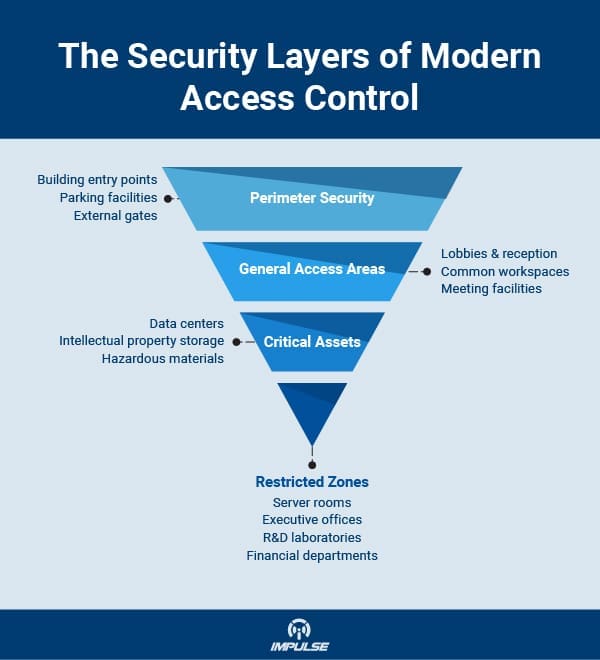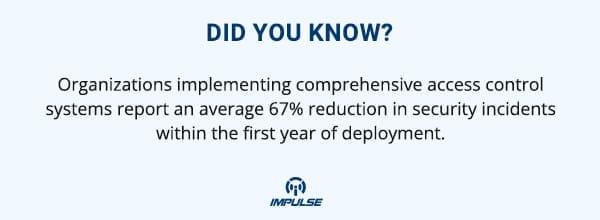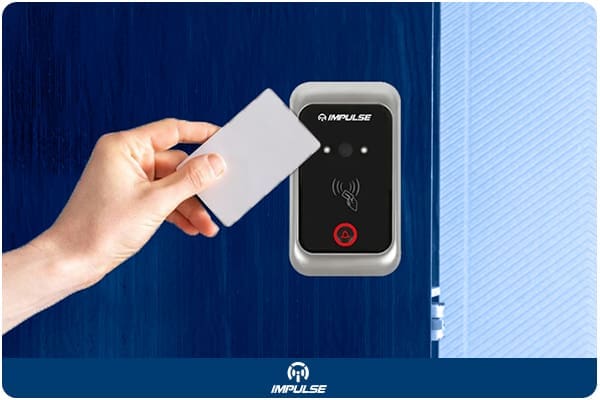Workplace security breaches continue to pose significant threats to businesses across industries. According to recent statistics, unauthorized access accounts for 43% of physical security incidents in commercial buildings, resulting in theft, data breaches, and compromised employee safety. Traditional lock-and-key systems create numerous security vulnerabilities – lost keys, unauthorized duplication, and the inability to track who enters specific areas and when.
Most concerning is that conventional security measures lack the sophisticated monitoring capabilities necessary in today’s dynamic workplace environments. Without proper access control mechanisms, businesses face increased vulnerability to internal theft, corporate espionage, and potential harm to employees. This security gap demands immediate attention as organizations grow and workspace complexity increases.
The Critical Need for Advanced Door Access Control
Modern workplaces require security solutions that provide both robust protection and operational flexibility. Door access control systems represent the technological evolution beyond traditional security methods, offering automated, customizable, and trackable entry management across workplace environments.
These systems enable organizations to precisely regulate who can access specific areas and under what conditions. By implementing specialized hardware and software infrastructure, businesses can dramatically enhance their security posture while gaining valuable insights into facility usage patterns.

Understanding Door Access Control Systems
Door access control systems comprise integrated components working together to secure entry points while providing detailed accountability. These systems typically include:
- Access credentials: Cards, fobs, biometric identifiers, or mobile credentials
- Readers and scanners: Devices that authenticate credentials at entry points
- Control panels: Central processing units managing system rules and authentication
- Electronic locking mechanisms: Electromagnetic locks, electric strikes, or smart locks
- Management software: Programs controlling permissions, schedules, and reporting
Modern systems like the TCP/IP Two Doors Access Control System and TCP/IP Four Doors Access Control System from Impulse CCTV represent the cutting edge of this technology, featuring TCP/IP connectivity for network integration and sophisticated management capabilities.
Access Control Security Implementation
The Rising Security Challenge
The rapid evolution of workplace threats demands sophisticated countermeasures. Traditional security approaches leave dangerous gaps in protection through which malicious actors can exploit vulnerabilities. Without comprehensive access control, organizations remain exposed to risks ranging from physical theft to data compromise and employee safety incidents.
The Strategic Advantage of Door Access Control
Door access control systems create a strategic security foundation that addresses multiple vulnerabilities simultaneously. By implementing tiered authentication protocols and centralized management, businesses gain significant advantages:
- Precision accountability – Digital tracking of all entry and exit events
- Customizable access rights – Tailored permissions based on role, department, and time
- Instant security modifications – Immediate credential deactivation when needed
- Integration capabilities – Synchronization with other security and management systems
Transformative Security Benefits
Advanced systems like the TCP/IP Two Doors Access Control System deliver transformative benefits that extend beyond basic security:
Enhanced Workplace Safety
Advanced access control systems enhance workplace safety through multiple layers of protection. They prevent unauthorized individuals from entering hazardous areas, enable immediate lockdown capabilities during emergencies, integrate with fire systems for efficient evacuation procedures, and provide comprehensive protection against workplace violence through strictly controlled access points.
Operational Efficiency
Door access control systems streamline operations by eliminating the need to manage physical keys, reducing security personnel requirements, automating entry logs for compliance purposes, and simplifying visitor management workflows.
Data-Driven Insights
Door access control systems provide valuable data-driven insights through comprehensive analytics capabilities. These include detailed space utilization metrics that aid in facility planning, seamless integration with time and attendance tracking systems, real-time occupancy monitoring for emergency response, and sophisticated pattern analysis to enhance security measures through behavioral insights.
Implementation Strategies for Maximum Security
Implementing door access control systems requires strategic planning and technology selection. Organizations should:
- Conduct a comprehensive security assessment to identify vulnerable areas
- Define access policies based on personnel roles and security requirements
- Select appropriate hardware components matching facility needs
- Deploy integrated management software for centralized control
- Establish ongoing maintenance protocols to ensure system integrity

Technology Spotlight: Advanced Access Control Solutions
Multi-Door Management Systems
The Power of Door Access Control Systems becomes evident with multi-door management capabilities. The TCP/IP Four Doors Access Control System represents an enterprise-grade solution offering centralized control over multiple entry points. This advanced system provides:
- Simultaneous management of four independent doors
- Regional interlocking functionality preventing sequential unauthorized entry
- Fire safety integration for emergency evacuation
- Dynamic 2D code generation for temporary access
- Cloud platform connectivity for remote management
This system proves particularly valuable for organizations needing to secure multiple departments or specialized areas while maintaining centralized security oversight.
Supporting Hardware Components
Complete access control installations require specialized hardware components working in concert:
- Switch Panel Door Exit Push Button Access Control – This durable stainless steel exit push button provides reliable egress functionality while maintaining security integrity.
- Access Control Housing with Power Supply Box – This housing provides crucial infrastructure support with built-in power supply and secure mounting for control boards, electromagnetic locks, and reader devices.
- 280KG Double Door Electromagnetic Lock – This electromagnetic lock delivers exceptional holding force for high-security areas, featuring an innovative epoxy-less design for superior durability and simplified installation.
Credential Management Systems
Modern access control extends beyond physical hardware to sophisticated credential management:
- ID Card Writer facilitates rapid programming of access credentials with high-speed data transmission via USB, eliminating the need for specialized driver installation.
- Metal RFID Card Reader employs advanced 13.56MHz technology with encryption algorithms for secure Wiegand output, combining high sensitivity with minimal error rates.

Selecting the Right Access Control System for Your Organization
Scalability Requirements
When evaluating access control systems, it’s crucial to consider your current facility size and any future expansion plans. This includes analyzing the total number of entry points that need protection across your premises. Additionally, you’ll want to carefully assess your current user population and projected growth to ensure the system can accommodate future needs.
Integration Capabilities
A modern access control system should seamlessly integrate with your existing security infrastructure. It needs to work harmoniously with your HR and operational systems for efficient user management and access provisioning. The system should also coordinate effectively with video surveillance systems to provide comprehensive security coverage.
Authentication Methods
Your access control solution should offer flexible authentication options, including traditional card/fob-based systems for general access areas. For high-security zones, consider implementing biometric verification methods. To accommodate modern workplace trends, ensure the system supports mobile credentials, allowing employees to use their smartphones for access.
Management Preferences
Consider whether you prefer an on-premises solution or a cloud-based administration system for your access control needs. Evaluate the importance of remote access capabilities for your security team. The system should also provide comprehensive reporting and analytics features to help you monitor and optimize security operations.
The Future of Workplace Access Security
Smart Access Control Systems continue to evolve with emerging technologies reshaping the security landscape:
- Artificial intelligence for anomaly detection and predictive security
- Touchless authentication methods addressing hygiene concerns
- Mobile credential dominance replacing physical cards
- IoT integration creating unified security ecosystems
- Analytics-driven security optimizing protection based on usage patterns
Organizations implementing Employee Access Control Solutions today position themselves at the forefront of workplace security innovation while establishing the technological foundation for future capabilities.
Implementation Success: A Strategic Approach
Successful deployment of Access Control for Offices requires thoughtful planning:
- Comprehensive Security Audit
- Identify all entry points requiring protection
- Assess current security vulnerabilities
- Document specific protection requirements by area
- Solution Selection
- Match technology capabilities to security needs
- Consider scalability for future requirements
- Evaluate integration capabilities with existing systems
- Implementation Strategy
- Develop detailed deployment timeline
- Create user training protocols
- Establish clear security policies and procedures
- Ongoing Optimization
- Regular security assessment reviews
- Software and firmware update processes
- Credential management procedures
Also Read: Two Door Access Control System: The Ultimate Guide
Conclusion
The implementation of robust door access control systems represents a critical investment in organizational security and employee safety. By deploying sophisticated solutions like those offered by Impulse CCTV, businesses can dramatically reduce security vulnerabilities while gaining valuable operational insights.
Modern Workplace Safety Solutions extend far beyond simple door locking mechanisms to create comprehensive security ecosystems that protect people, property, and information. The strategic deployment of these systems establishes a foundation for ongoing security improvement while demonstrating organizational commitment to employee protection.
As workplace environments continue to evolve, the sophisticated capabilities of modern access control will play an increasingly central role in comprehensive Office Security Systems strategies.
Learn how modern door access control systems can enhance your workplace security. Impulse CCTV offers simple, effective solutions for your needs.


